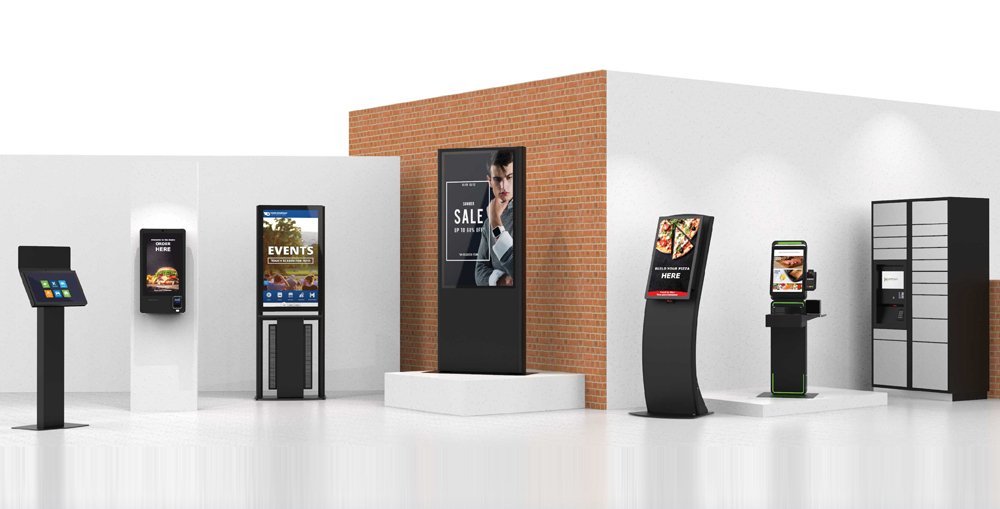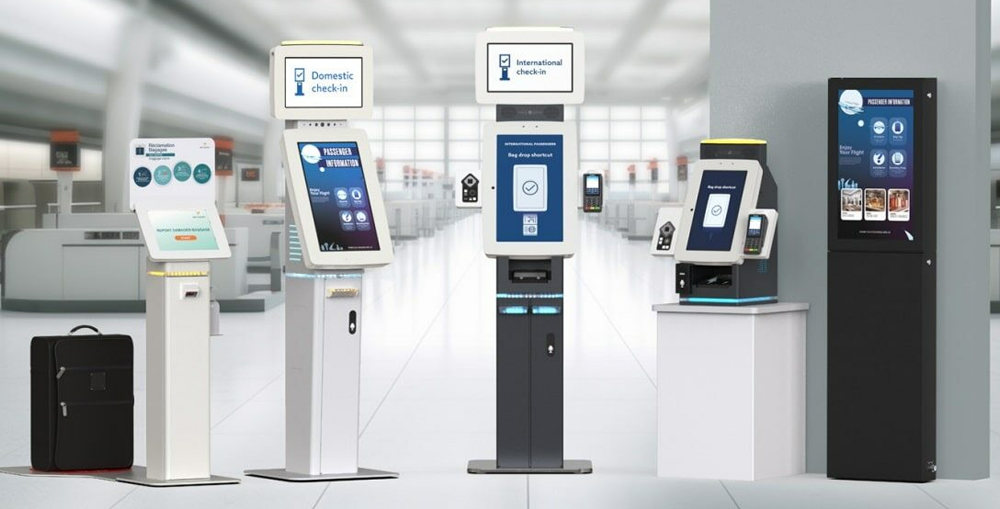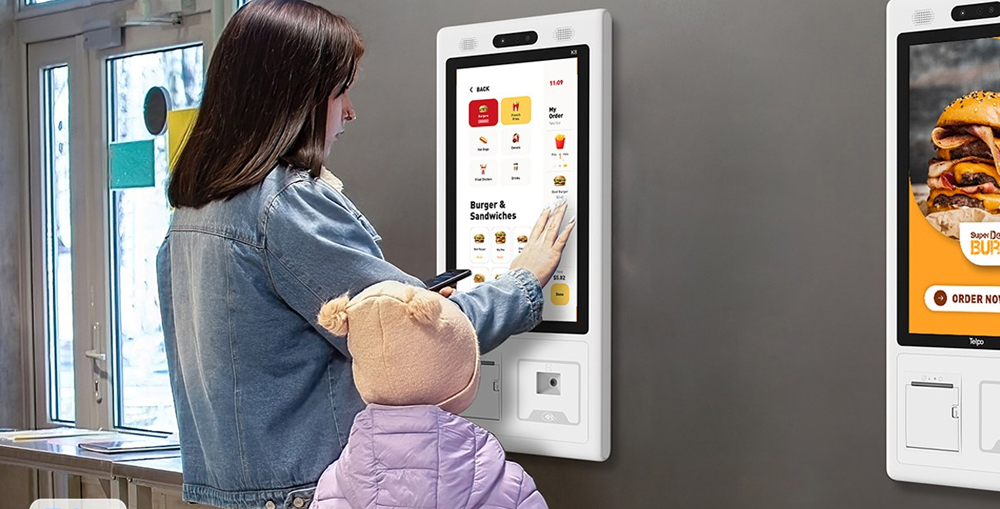In service sector the customer satisfaction is a mission-critical goal which have huge impact on business’s reputation and long-term success. Regardless of your industry or business type, the customer satisfaction impacts almost every aspect of your business. The loyal customers are more profitable, they tend to do repeated business and are good brand advocate, helping brands to establish good repute. Moreover the customer satisfaction and meeting to customers’ expectations help reducing customer churn and increase sales. The self-check-in kiosks are a great solution to enhance and elevate customer experience and raise customer satisfaction. Check-ins and registration is a common bottleneck, and in fact it is a pain point, where customers felt stuck. Streamlining check-in process remove friction and streamline customer flow.
Self-check-in kiosks are specialized version of interactive self-service kiosks that enable customers and visitors to check-in or register without interacting with the clerk or staff. This autonomous check-in process is simpler, more efficient and convenient for the visitors. Whether it is a hotel, hospital, airport, exhibition, or a government service center, the self-check-in kiosks are transforming the many industries worldwide. Implementing a self-check-in kiosk makes check-ins and registration more user-friendly, quicker and convenient. It help streamlining customer/guest flow, reduce average wait time and help businesses generate more revenue. Autonomous registration and check-ins help improving human resource management and have positive impact on the overall operational efficiency and performance.

The Impact of Self-Check-in Kiosks on Customer Satisfaction
How Self-Check-In Kiosk Works?
Fundamentally a self-check-in kiosk is an interactive self-service kiosk, but with specialized software and hardware features. Essentially it is a computer terminal equipped with a touch screen and a few peripherals as per the needs. Every industry and business have its own needs and preference, for example, a hotel check-in might just require a QR Code/Barcode scan and a few tap on the screen, whereas a government service might require payment and document scanning as well. A self-check-in kiosk can have multiple peripheral devices such as Keyboard, Mouse Pad, Touch Pen Input, QR Code/Barcode scanner, Emirates ID scanner, CCTV or Facial Recognition Camera, Biometrics, Credit/Debit Card, Cash Payment, NFC, RFID, Passport Scanner, Document Scanner, Thermal Printer, Document Printer, Wristband Printer, Visitor Badge Printer, etc.
Apart from a wide range of hardware peripherals, the software too offers a wide spectrum of customizable features and integration with existing systems, databases, and core business applications. Both the software and hardware together are exclusively designed to facilitate the check-in workflows and process. Moreover the self-check-in kiosks can also offer multi-lingual support, which further helps improving and personalizing the customer/guest experience. Typically all self-check-in kiosks are integrated with existing systems, databases and core business applications, but they can also operate as a standalone touch point. The integration pave way for simplified user operation and quicker service delivery, driving automation and efficiency in internal business processes and workflows, while effectively enhancing user experience.

How Self-Check-In Kiosk Works?
How Self-Check-In Kiosks Elevate Customer Satisfaction?
The self-check-in kiosks offer great many features that can help enhancing customer experience. Moreover these kiosks are customizable, hence every business can customize those features as per their needs and goals. The main objective of self-check-in kiosk is to provide a user-friendly and efficient channel to allow customer and guests to register, check-in or access information.
Here are some key features of self-check-in kiosk that have huge impact on customer behavior and help businesses elevating customer experience:
- Faster Service and Less Wait: Self-check-in kiosk drastically reduce average customer/guest wait time, as instead of waiting for a front desk clerk or staff, multiple customers can use different kiosks. This reduce the congestion at check-in and help streamlining the process.
- Control and Convenience: The self-check-in kiosks offer user-friendly multi-lingual intuitive UIs (user interfaces). The on-screen prompts and instruction make process simple and give customer full control of what information they share and prevent any error or need of repetition.
- Consistent Customer Experience: The self-check-in kiosks always operate the same way, so most of the time customers/guests know what to expect. Furthermore the on-screen prompts and review reduce any error before submission and elevate the accuracy of the process.
- Personalization and Upselling: The self-check-in kiosks comes with an intelligent AI-powered software application. It can personalize customer experience as per their profile and persona and it can also promote additional add-ons such as amenities and upgrades to improve upselling.
- Contactless Interaction: The self-check-in kiosks can offer contactless experience for swift and safe check-in. Customers can scan a QR Code/Barcode and sign-in, these kiosks also offer contactless payments which help elevating customer experience and reduce wait time.
- Enhance Operational Efficiency: When the customers/guests are check-in or registering through the self-check-in kiosks the staff gets free and have more time to focus on servicing customers or answering their question or attending unhappy customers which raise productivity and enhance operational efficiency.
- Customization: The self-check-in kiosks are very flexible solutions, businesses can customize them to align with their internal workflows and check-in/registration processes. This customization not only seamlessly integrate these kiosks but also drive efficiency through automation.
- Scalability and Upgrade: An average self-check-in kiosk can remain operational for many years. They require very less maintenance and adding more kiosk to system bears no additional cost. Moreover businesses can further customize or upgrade them according to emerging needs.
- Third-Party Integration: The self-check-in kiosks offer simple and secure API based third-party system integration. This enable them to connect and synchronize with existing core business applications, CRMs, ERPs, or feedback systems for better automation and innovative features.
- Easy Deployment: The self-check-in kiosks can easily be setup in a plug-and-play configurations. The service-side application can be deployed on a cloud, the kiosk can go live simply by connecting them with WiFi or internet. Hence businesses can easily deploy or relocate them.
A self-check-in kiosk can greatly improve the registration and check-in process. Greeting your customers with an immersive digital experience help business build a positive first impression. Faster check-ins, less wait time, and multiple check-in options help enhancing customer experience and raise satisfaction. Waiting in long queues or delays at the reception cause frustration and hurt business reputation. A customized self-check-in kiosk is an ideal solution to raise customer satisfaction by automating check-ins and optimizing operational efficiency. All these features greatly help businesses improve the customer experience and raise their satisfaction.

How Self-Check-In Kiosks Elevate Customer Satisfaction?
How Self-Check-In Kiosks are Elevating Customer Satisfaction in Different Industries
Many industries are leveraging self-check-in kiosks. As every industry is different these kiosks are customized to offer features aligned with a specific industry needs. This customization make self-check-in kiosk much more effective and efficient. Moreover each individual business can further customize these kiosks to incorporate innovative features and align customer experience with their strategic objectives. Here are a few industries where the adoption of interactive self-check-in kiosks are surging:
- Hotels and Hospitality: The hotels and other businesses in hospitality sector are leveraging self-service hotel check-in kiosks to enable their guests to quickly and conveniently check-in, choose amenities, make payments or issue room keys, without requiring to stand in long queues. The digital interaction not only convene check-ins but also offer better privacy, and easy access to information which is much appreciated by the guests.
- Airports Passenger Check-Ins: All major airports around the world today offers self-check-ins to print baggage tags, boarding pass, customize travel plans, upgrade amenities and even purchase ticket from these passenger check-in kiosks. Self-check-in kiosks not only improve passenger experience but also help improving airport operations. Airports have reported a steep decline of around 20-22 percent in passenger wait time after implementing passenger-check-in kiosk.
- Patient Check-In in Healthcare: Hospitals and clinics are also adopting self-check-in kiosks, especially in their emergency and OPDs. A self-check-in kiosk at a healthcare facility help reducing the patient wait time. It help reducing the complexity of check-ins and reduce average check-in time. Moreover patients can quickly check or reschedule their appointments, update medical or insurance details, and even make payments by simply swiping their credit/debit cards.
- Exhibition and Events: Self-check-in kiosks are rapidly adopted by exhibition and event management organizations. A self-check-in kiosk enable visitors to quickly register, make payments, or print badges and access information. Visitors who have registered via online can simply scan a QR Code and print their badges or make payments by a few taps on screen. The self-check-in kiosks can greatly improve visitor experience at an exhibition booth and help enhancing operational efficiency.
- Government and Public Services: A self-check-in kiosk at a government agency or public service office help dealing with several challenges. The large volume of daily visitors can be distributed and the customers can do registration, make payments, check status, access to information, scan documents, print documents, and much more. Any service from a very simple payment to complex multi-step registration process can be delivered effectively through these kiosks.
The self-check-in kiosks are very potent solutions and a well-crafted tailored self-check-in kiosk can be game changer for your business or organization. Many industries are adopting self-check-in kiosks to enhance and elevate customer experience. A self-check-in kiosk not just provide alternate service channels, but it can greatly improve the resource management. These kiosks can collect valuable business intelligence data which help businesses in data-driven decision making. Moreover these kiosks can operate 24/7, require very less maintenance and can remain relevant for many years. These features make them a high ROI solution for modern businesses and raise their future readiness.

How Self-Check-In Kiosks are Elevating Customer Satisfaction in Different Industries
Overcoming Challenges and Implementation Best Practices
Same like any other new technology, implementing and adopting to self-check-in kiosks or even any other type of interactive self-service kiosks can be a bit challenging, especially for those businesses who are new to this technology. Here are a few challenges and implementation best practices for the self-check-in kiosks:
- Availability Issue: Businesses often doesn’t count the fact that any kiosk can go offline, due to internet connectivity issue or simply power issue. Thus fix positioning with proper cabling can avoid this. Furthermore a backup kiosk can help replacing the faulty one for short time without causing any interruption in service.
- Customer’s Technical Understanding: Not all customers are proficient with technology, some prefer the traditional human-interaction. Thus ensuring that your staff is always present can help you serving such customers. Moreover multi-lingual support also help encouraging more customers to use self-check-in kiosks.
- User-Friendly Interfaces: The self-check-in kiosks should have user-friendly user interfaces which should be properly optimized for touch screens. The button should be bigger and bolder, the on-screen prompts and multi-lingual support will help enhancing customer experience. A user-friendly user interface will also help building a positive impression on your customers/guests.
- Accessibility: Businesses often neglect accessibility issues in these kiosks. A self-check-in kiosk should be accessible for all, even for people with disabilities. Adjustable screen, voice-command enabled UIs, and compliance with accessibility standard can help you make your kiosks more accessible and available for a wider audience.
- Integration with Existing Systems: The modern day businesses heavily rely on information and data flow. Usually businesses use multiple IT and digital solutions. The information is scattered across several system. Integrating self-check-in kiosk with existing software solutions, databases, mobile apps and core business applications can greatly improve the functionality and efficiency.
- Privacy and Security: People usually feel worried while entering their private and personal information into a machine that is publicly available for anyone. A simple privacy screen, indicating automatic sign-out and a security camera can help gaining trust. Moreover the kiosk should be placed at a well-lit and secure indoor location to further improve trust.
These simple yet very effective tips will help you mitigate several problems that may occur during or after implementation of a self-check-in kiosk. Furthermore businesses can utilize the analytical data of these kiosks to understand how many customers/guests are using them verses how many are still relying on traditional over the counter check-ins. Moreover businesses can integrate a simple feedback to understand how effective their self-check-in kiosk is. Feedback will help highlighting the features your customers may like and it will also identify the areas of improvement for future.

Overcoming Challenges and Implementation Best Practices
Conclusion
The self-check-in kiosks are not just a simple technology upgrade, but it is a very powerful and transformative tool. Businesses can utilize tailored self-check-in kiosks to enhance customer satisfaction. These kiosks are excellent at optimizing operational efficiency and tend to return very high ROI in long-term. Moreover in this modern day and age where the market landscape is highly competitive and the customer demands are rising day by day, businesses need a digital solution that can easily adopt to their emerging needs without requiring to make huge investments.
A self-check-in kiosk help facilitating and elevating check-in and registration processes and offer easy and simple customization which help businesses to easily align these solutions with their emerging needs. These kiosks often return your investments very quickly by elevating customer experience, raising revenue, optimizing human resource and decreasing labor cost. The customers also tend to lean towards digital interaction over the traditional experience. Especially in Dubai, Sharjah, Abu Dhabi and other regions of UAE where the digitalization and smart solutions are part of normal lifestyle, customer might expect a digital solution at their favorite service provider.
In this blog we have briefly discussed what self-check-in kiosks are and how they operate. We have also enlisted their key benefits and features that help elevating customer satisfaction and operational efficiency. If you want to learn more about the subject or if you want our help to tailor-made a self-check-in kiosk for you, please feel free to contact us through our Contact Us page or leave a comment in the comment box below and we will get in touch with you soon.
